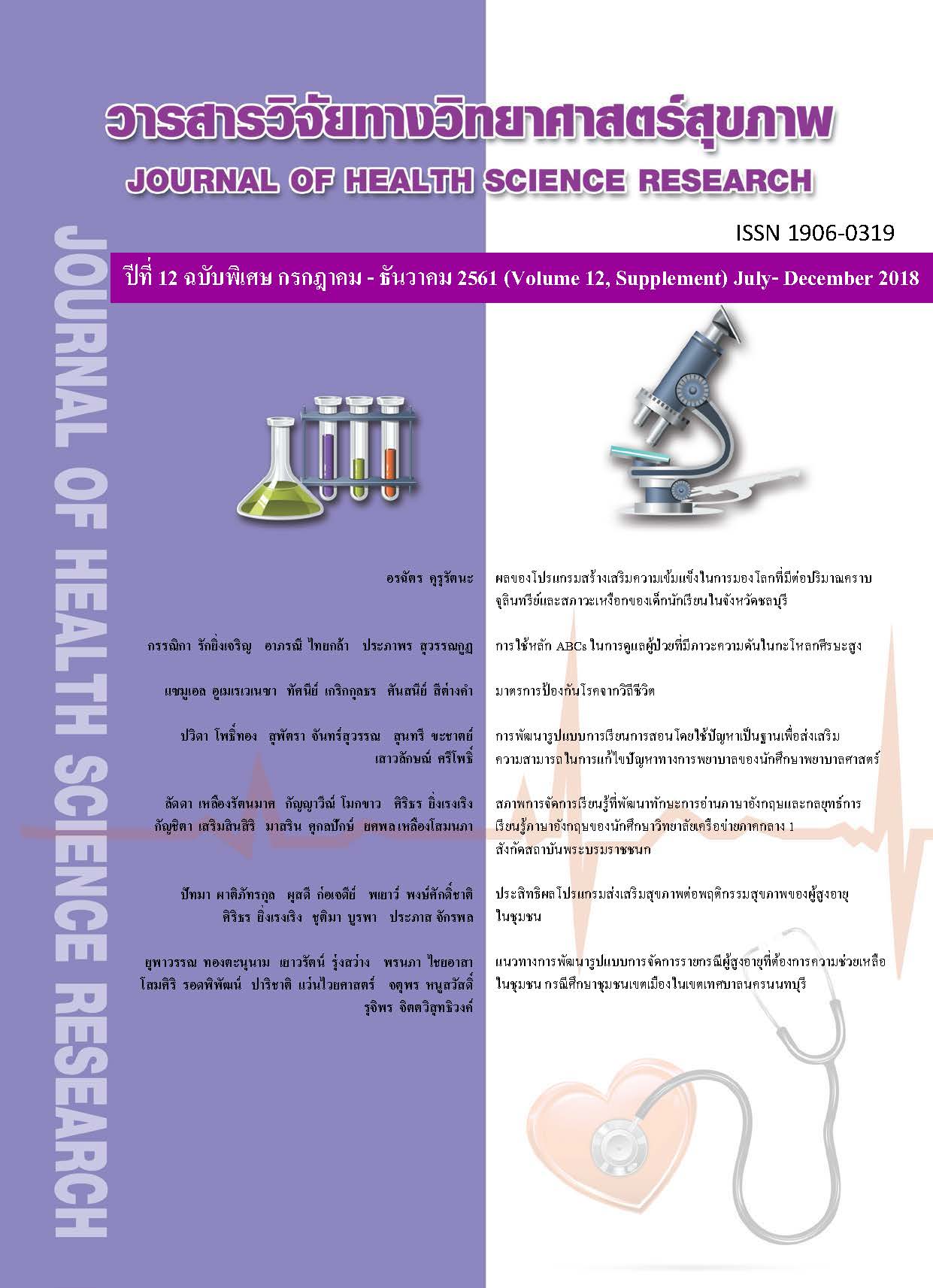ผลของโปรแกรมสร้างเสริมความเข้มแข็งในการมองโลกที่มีต่อปริมาณคราบจุลินทรีย์ และสภาวะเหงือกของเด็กนักเรียนในจังหวัดชลบุรี
Main Article Content
บทคัดย่อ
การให้ทันตสุขศึกษามีข้อจำกัดคือทำให้สุขภาพช่องปากดีขึ้นเพียงชั่วคราว การวิจัยกึ่งทดลองชนิด 2 กลุ่มนี้ศึกษา ผลของการฝึกความเข้มแข็งในการมองโลกที่มีต่อปริมาณคราบจุลินทรีย์และสภาวะเหงือกในระยะยาว กลุ่มตัวอย่างเป็นเด็กอายุ 11-13 ปี ในจังหวัดชลบุรี จำนวน 191 คน กลุ่มทดลองได้รับโปรแกรมสร้างเสริมความเข้มแข็งในการมองโลก กลุ่มควบคุมได้รับโปรแกรมตามปกติของโรงเรียน เก็บข้อมูลโดยการตรวจปริมาณคราบจุลินทรีย์ สภาวะเหงือกและประเมินความเข้มแข็งในการมองโลก พบว่า ก่อนการทดลองกลุ่มทดลอง และกลุ่มควบคุมมีปริมาณคราบจุลินทรีย์ ค่าเฉลี่ย 1.34 (SD=0.43) และ 1.35 (SD=0.49) ตามลำดับ p = 0.87 สภาวะเหงือก ค่าเฉลี่ย 1.42 (SD=0.44) และ 1.44 (SD=0.55) ตามลำดับ p = 0.76 และความเข้มแข็งในการมองโลก ค่าเฉลี่ย 57.00 (SD=9.47) และ 56.81 (SD=10.86) ตามลำดับ p = 0.90 ไม่แตกต่างกัน หลังการทดลอง 1 สัปดาห์ กลุ่มทดลองมีปริมาณคราบจุลินทรีย์ต่ำกว่ากลุ่มควบคุม ค่าเฉลี่ย 0.73 (SD=0.27) และ 1.08 (SD=0.38) ตามลำดับ p < 0.001 มีสภาวะเหงือกดีกว่ากลุ่มควบคุม ค่าเฉลี่ย 0.84 (SD=0.38) และ 1.40 (SD=0.43) ตามลำดับ p < 0.001 และความเข้มแข็งในการมองโลกสูงกว่ากลุ่มควบคุมอย่างมีนัยสำคัญทางสถิติ ค่าเฉลี่ย 59.96 (SD=10.80) และ 56.47 (SD=11.74) ตามลำดับ p = 0.03 หลังการทดลอง 1 เดือน กลุ่มทดลองมีปริมาณคราบจุลินทรีย์ต่ำกว่ากลุ่มควบคุม ค่าเฉลี่ย 0.93 (SD=0.23) และ 1.07 (SD=0.20) ตามลำดับ p < 0.001 มีสภาวะเหงือกดีกว่ากลุ่มควบคุม ค่าเฉลี่ย 0.95 (SD=0.35) และ 1.16 (SD=0.33) ตามลำดับ p < 0.001 และความเข้มแข็งในการมองโลกสูงกว่ากลุ่มควบคุมอย่างมีนัยสำคัญทางสถิติ ค่าเฉลี่ย 59.62 (SD=11.26) และ 55.58 (SD=12.37) ตามลำดับ p = 0.02 ผลของโปรแกรมดังกล่าวในการสร้างเสริมสุขภาพช่องปากยังคงอยู่ แม้ว่าโปรแกรมจะสิ้นสุดไปแล้ว 1 เดือน
Downloads
Article Details
บทความที่ได้รับการตีพิมพ์เป็นลิขสิทธิ์ของวิทยาลัยพยาบาลบรมราชชนนี จังหวัดนนทบุรี
ข้อความที่ปรากฏในบทความแต่ละเรื่องในวารสารวิชาการเล่มนี้เป็นความคิดเห็นส่วนตัวของผู้เขียนแต่ละท่านไม่เกี่ยวข้องกับวิทยาลัยพยาบาลบรมราชชนนี จังหวัดนนทบุรี และคณาจารย์ท่านอื่น ในวิทยาลัยฯ แต่อย่างใด ความรับผิดชอบองค์ประกอบทั้งหมดของบทความแต่ละเรื่องเป็นของผู้เขียนแต่ละท่าน หากมีความผิดพลาดใด ๆ ผู้เขียนแต่ละท่านจะรับผิดชอบบทความของตนเองแต่ผู้เดียว
เอกสารอ้างอิง
2.Bureau of Dental Health, Department of Health, Ministry of Public Health. 7th National Oral Health Survey in Thailand 2012. Bangkok: WVO Office of Printing Mill; 2013. (in Thai).
3.Antonovsky A. Unraveling the mystery of health: How people manage stress and stay well. San Francisco, CA: Jossey-Bass; 1987.
4.Abdelgadir M, Shebeika W, Eltom M, Berne C, Wikblad K. Health related quality of life and sense of coherence in Sudanese diabetic subjects with lower limb amputation. Tohoku J Exp Med. 2009;217(1): 45-50.
5.Badura-Brzoza K, Zajac P, Brzoza Z, Kasperska-Zajac A, Matysiakiewicz J, Piegza M, et al. Psychological and psychiatric factors related to health-related quality of life after total hip replacement-preliminary report. Eur Psychiatry. 2009;24(2):119-24.
6.Ayo-Yusuf OA, Reddy PS,van den Borne BW. Longitudinal association of adolescents’ sense of coherence with tooth-brushing using an integrated behavior change model. Community Dent Oral Epidemiol. 2009;37(1):68-77.
7.Dorri M, Sheiham A, Hardy R, Watt R. The relationship between sense of coherence and toothbrushing behaviours in Iranian adolescents in Mashhad. J Clin Periodontol. 2010;37(1):46-52.
8.Lindmark U, Hakeberg M. Hugoson A. Sense of coherence and its relationship with oral health-related behaviour and knowledge of and attitudes towards oral health. Community Dent Oral Epidemiol. 2011;39(6): 542-53.
9.Kay E, Locker D. A systematic review of the effectiveness of health promotion aimed at improving oral health. Community Dental Health. 1998;15(3): 132-44.
10.Watt R, Fuller S, Harnett R. Treasure E, Stillman-Lowe C. Oral health promotion evaluation--time for development. Community Dent Oral Epidemiol. 2001; 29(3):161-6.
11.Nammontri O, Robinsion PG, Baker SR. Enhancing oral health via sense of coherence: A cluster-randomized trial. J Dent Res. 2013;92(1):26-31.
12.Mattila ML, Rautava P, Honkinen PL, Ojanlatva A, Jaakkola S, Aromaa M, et al. Sense of coherence and health behaviour in adolescence. Acta Paediatr. 2011; 100(12):1590-5.
13.Schlesselman JJ. Planning a longitudinal study. I. Sample size determination. J Chronic Dis. 1973; 26(9):553-60.
14.Silness J, Loe H. Periodontal disease in pregnancy. II. Correlation between oral hygiene and periodontal condition. Acta Odontol Scand. 1964;22:121-35.
15.Lobene RR, Weatherford T, Ross NM, Lamm RA, Menaker L. A modified gingival index for use in clinical trial. Clin Prev Dent. 1986;8(1):3-6.
16.Heyman HO, Swift EJ, Ritter AV, editors. Sturdevant’s art and science of operative dentistry. 6th ed. St. Louis: Mosby; 2012.
17.Reddy KS, Doshi D, Kulkarni S, Reddy BS, Reddy MP. Correlation of sense of coherence with oral health behaviors, socioeconomic status, and periodontal status. J Indian Soc Periodontol. 2016;20(4):453-9.
18.Ayo-Yusuf OA, Reddy PS, van den Borne BW. Adolescents' sense of coherence and smoking as longitudinal predictors of self-reported gingivitis. J Clin Periodontol. 2008;35(11):931-7.
19.Peker K, Bermek G, Uysal O. Factors related to sense of coherence among dental students at Istanbul University. J Dent Educ. 2012;76(6):774-82.
20.Bernabe E, Watt RG, Sheiham A, Suominen-Taipale AL, Uutela A, Vehkalahti MM, et al. Sense of coherence and oral health in dentate adults: findings from the Finnish Health 2000 survey. J Clin Periodontol. 2010;37(11):981-7.
21.Page RC, Schroeder HE. Pathogenesis of inflammatory periodontal disease. A summary of current work. Lab Invest. 1976;34(3):235-49.
22.Rahman B, Kawas SA. The relationship between dental health behavior, oral hygiene and gingival status of dental students in the United Arab Emirates. Eur J Dent. 2013;7(1):22-7.
23.Elyasi M, Abreu LG, Badri P, Saltaji H, Flores-Mir C, Amin M. Impact of sense of coherence on oral health behaviors: A systematic review. PloS One. 2015;14; 10(8):e0133918.


